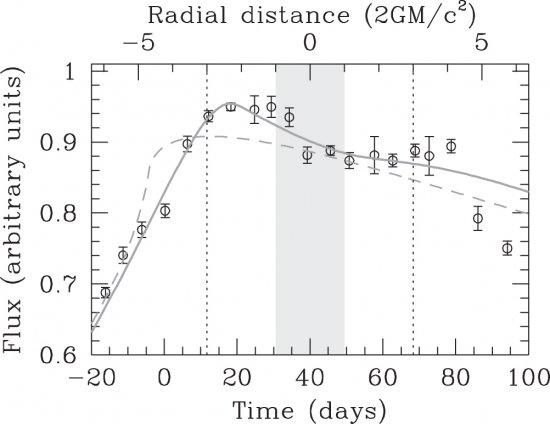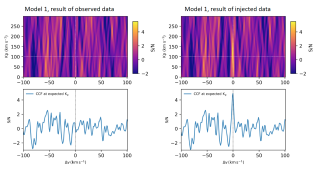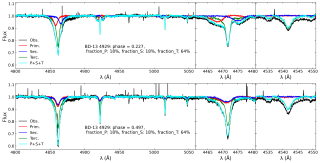The one-way frontier around a black hole is the event horizon from which nothing can escape. Close to it, strong effects of gravity and exotic physics are expected. The most massive black holes are at the centre of distant quasars, which cannot be resolved by telescopes. Fortunately, in some quasars aligned with an intervening galaxy, gravitational microlensing can magnify very small regions within the quasar allowing horizon scale resolution. We have used three events of gravitational microlensing that scan the source of a lensed quasar (Einstein Cross) to resolve a structure, affected by relativistic effects, located at three times the horizon radius, likely the inner rim of the disk of in spiralling matter that surrounds the black hole. In the future, with massive monitoring programs (with the Large Synoptic Survey Telescope, for instance) the possibility of detecting high magnification microlensing events can be extended to thousands of quasars (i.e. hundreds of high magnification microlensing events detected) with a huge improvement in statistical and evolutive (currently known lensed quasars are distributed in 0.5<z<5 redshift) studies of supermassive black holes and accretion discs.
Profile of a quasar accretion disk magnified by microlensing. The continuous curve corresponds to a relativistic model with innermost stable orbit at 3 Schwarzschild radii. Notice that one of the peaks is enhanced by relativistic beaming. The dashed curve
Advertised on
References
More info
RESOLVING THE INNERMOST REGION OF THE ACCRETION DISK OF THE LENSED QUASAR Q2237+0305 THROUGH GRAVITATIONAL MICROLENSING
We study three high magnification microlensing events, generally recognized as probable caustic crossings, in the optical light curves of the multiply imaged quasar Q2237+0305. We model the light curve of each event as the convolution of a standard thin disk luminosity profile with a straight fold caustic. We also allow for a linear gradient that can account for an additional varying background effect of microlensing. This model not only matches noticeably well the global shape of each of the three independent microlensing events but also gives remarkably similar estimates for the disk size parameter. The measured average half-light radius, R1 2 = ( ) 3.0 1.5 0.3 M M light-days, agrees with previous estimates. In the three events, the core of the magnification profile exhibits “fine structure” related to the innermost region of the accretion disk (located at a radial distance of 2.7 ± 1.4 Schwarzschild radii according to our measurement). Relativistic beaming at the internal rim of the accretion disk can explain the shape and size of the fine structure, although alternative explanations are also possible. This is the first direct measurement of the size of a structure, likely the innermost stable circular orbit, at ∼3 Schwarzschild radii in a quasar accretion disk. The monitoring of thousands of lensed quasars with future telescopes will allow the study of the event horizon environment of black holes in hundreds of quasars in a wide range of redshifts (0.5 < z < 5).
Year
2015



